Practice Essentials
Ebola virus is one of at least 30 known viruses capable of causing viral hemorrhagic fever syndrome. The genus Ebolavirus is currently classified into 5 separate species: Sudan ebolavirus, Zaire ebolavirus, Tai Forest (Ivory Coast) ebolavirus, Reston ebolavirus, and Bundibugyo ebolavirus. The outbreak of Ebola virus disease in West Africa from 2014 to 2016, involving Zaire ebolavirus, was the largest outbreak of Ebola virus disease in history.
Ebola virus. Courtesy of the US Centers for Disease Control and Prevention.
As of September 17, 2019, an active outbreak of Ebola virus disease in the Democratic Republic of the Congo (DRC) had resulted in 3,034 confirmed and 111 probable cases of Ebola virus disease, including 2,103 attributable deaths.
An experimental vaccine has been credited with limiting the outbreak’s scope.
Signs and symptoms
The following 2 types of exposure history are recognized:
Primary exposure – This typically involves travel to or work in an Ebola-endemic area.
Secondary exposure – This refers to human-to-human exposure (eg, medical caregivers, family caregivers, or persons who prepared deceased patients for burial), primate-to-human exposure (eg, animal care workers who provide care for primates), or persons who collect or prepare bush meat for human consumption.
Physical findings depend on the stage of disease at the time of presentation. With African-derived Ebolavirus infection, there is an incubation period (typically 3-8 days in primary cases and slightly longer in secondary cases).
Early findings may include the following:
Fever
Pharyngitis
Severe constitutional signs and symptoms
Maculopapular rash (best seen in white patients)
Bilateral conjunctival injection
Later findings may include the following:
Expressionless facies
Bleeding from intravenous (IV) puncture sites and mucous membranes
Myocarditis and pulmonary edema
In terminally ill patients, tachypnea, hypotension, anuria, and coma
Survivors of Ebola virus disease have developed the following late manifestations:
Myalgias
Asymmetric and migratory arthralgias
Headache
Fatigue
Bulimia
Amenorrhea
Hearing loss
Tinnitus
Unilateral orchitis
Suppurative parotitis
Diagnosis
Diagnostic studies that may be helpful include the following:
Basic blood tests – Complete blood count (CBC) with differential, bilirubin, liver enzymes, blood urea nitrogen (BUN), creatinine, pH
Studies for isolating the virus – Tissue culture (only to be performed in one of a few high-containment laboratories throughout the world), reverse-transcription polymerase chain reaction (RT-PCR) assay
Serologic testing – Enzyme-linked immunosorbent assay (ELISA) for antigens or for immunoglobulin M (IgM) and immunoglobulin G (IgG) antibodies
Other studies – Immunochemical testing of postmortem skin, electron microscopy
Management
General principles of care are as follows:
Supportive therapy with attention to intravascular volume, electrolytes, nutrition, and comfort care is of benefit to the patient.
Such therapy must be administered with strict attention to barrier isolation; all body fluids contain infectious virions and should be handled with great care.
No specific therapy is available that has demonstrated efficacy in the treatment of Ebola hemorrhagic fever.
Ebola Zaire vaccine is approved in Europe and the United States. The live recombinant vaccine has shown effectiveness of 97.5% in preventing infection among 90,000 individuals in an active Ebola virus outbreak in the Democratic Republic of Congo.
The FDA approved
atoltivimab/maftivimab/odesivimab (Inmazeb), a recombinant human monoclonal antibody combination. These antibodies target the glycoprotein (GP) on the Ebola virus surface, thereby blocking attachment and entry of the virus on host cell membranes.
Other agents that have been studied for the treatment or prevention of Ebola virus disease include the following:
Ribavirin (possesses no demonstrable anti-
Ebolavirus activity in vitro and has failed to protect
Ebolavirus -infected primates)
Nucleoside analogue inhibitors of S-adenosylhomocysteine hydrolase (SAH)
Interferon beta
Horse- or goat-derived immune globulins
Human-derived convalescent immune globulin preparations
Recombinant human monoclonal antibodies
Recombinant human interferon alfa-2
Activated protein C
Recombinant inhibitor of factor VIIa/tissue factor
In those patients who do recover, recovery often requires months, and delays may be expected before full resumption of normal activities. Weight gain and return of strength are slow. Ebola virus continues to be present for many weeks after resolution of the clinical illness.

